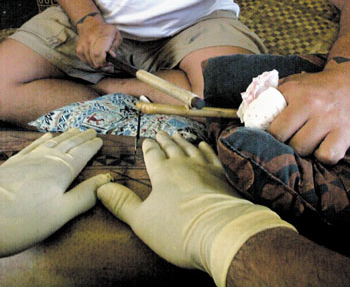|
| In Samoa, the tradition of applying tattoo, or tatau, by hand has been unbroken for over two thousand years. Tools and techniques have changed little. The skill is often passed from father to son, each tattoo artist, or tufuga, learning the craft over many years of serving as his father's apprentice. A young artist-in-training often spent hours, and sometimes days, tapping designs into sand or tree bark using a special tattooing comb, or au. Honoring their tradition, Samoan tattoo artists made this tool from sharpened boar's teeth fastened together with a portion of the turtle shell and to a wooden handle.
|
Traditional Samoan tattooing of the “pe'a”, body tattoo, is an ordeal that is not lightly undergone. It takes many weeks to complete. The process is very painful and used to be a necessary prerequisite to receiving a matai title; this however is no longer the case. Tattooing was also a very costly procedure. |
| It was not uncommon for half a dozen boys to be tattooed at the same time, requiring the services of four or more artists. It was not just the men who received tattoos, but the women too; their designs are of a much lighter nature rather than having the large areas of solid dye which are frequently seen in men’s tattoos. The tattooing of women was not nearly as ritualized like men’s were. |
|
Info courtesy of: |
| https://en.wikipedia.org/wiki |


